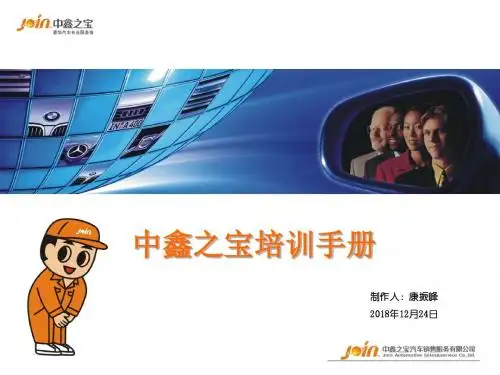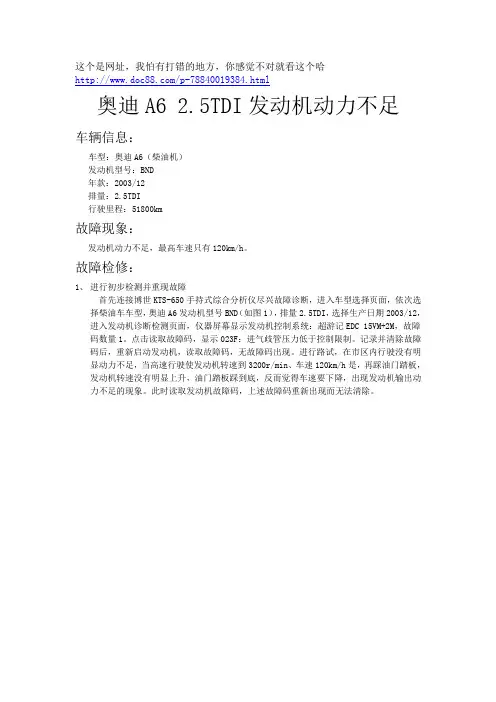第二篇_最新奥迪2_5L-TDI-V6发动机培训教程
- 格式:ppt
- 大小:1.32 MB
- 文档页数:19



奥迪发动机高级培训内容一汽-大众发动机高级培训(AB025)奥迪汽油发动机培训内容一汽-大众发动机高级培训(AB025)学习目的:学习奥迪用发动机结构、工作原理、故障诊断及检测内容一汽-大众发动机高级培训(AB025)发动机基本工作原理工作行程进气冲程进气阀打开:最大45°上止点前ANQ 16°上止点后AWL 18°上止点后APS 12°上止点后ATX 12°上止点后进气阀关闭:35°-90°下止点后ANQ 38°下止点后AWL 28??下止点后APS 42°下止点后ATX 36°下止点后占空系数:max. 80%空气流速:约. 100m/s内容一汽-大众发动机高级培训(AB025)压缩冲程压缩比: ANQ 10,3:1AWL 9.5:1 APS 10,5:1 ATX 10,1:1气流速: 约. 100m/s压缩压力: max. 18bar 起动时,压缩压力: ANQ: 9 ~14 barAWL: 9 ~14 bar APS: 9 ~14 bar ATX: 9 ~14 bar 燃气温度:400°-500°内容一汽-大众发动机高级培训(AB025)工作冲程点火时刻:由特性曲线控制燃烧速度:约. 20m/s燃烧温度°-2500°燃烧最高压力:30bar -60 bar内容一汽-大众发动机高级培训(AB025)排气冲程排气阀打开:40°-90°下止点前ANQ 38°下止点前AWL 28??下止点前APS 38°下止点前ATX 38°下止点前排气阀关闭:上止点后ANQ 8°上止点前AWL 8°上止点前APS 8°上止点前ATX 8°上止点前气流速:约为音速尾气温度:约900°C内容一汽-大众发动机高级培训(AB025)发动机内充分燃烧点火空气最佳燃烧燃油内容一汽-大众发动机高级培训(AB025)燃油空气1 kg14,8 kg空气系数:空气与燃油混合气只有在特定的混合比例下,才能充分点火燃烧3充分燃烧1kg 汽油,需14.8kg(约12m)空气(指化学比例)在此比例时,空气系数空气供给量z= =1理论需求量z >1 空气过多,稀混合气z<1 空气过少,浓混合气内容一汽-大众发动机高级培训(AB025)燃油空气空气系数:1 kg14,8 kg空气不足0-10%时,发动机发出最大功率.z = 1.....0,9在空气过剩约10%时,油耗最小z ~ 1,1空气不足时燃油不能充分燃烧因此,废气中有害物质增多.空气过剩时,功率下降,燃烧温度升高内容一汽-大众一、外部轮系的组成、发动机高级培训(AB025)调整方法及要求内容一汽-大众发动机高级培训(AB025)二、机体及曲柄连杆机构内容一汽-大众发动机高级培训(AB025)内容一汽-大众发动机高级培训(AB025)缸盖螺栓缸套螺纹金属缸垫内容一汽-大众发动机高级培训(AB025)内容一汽-大众发动机高级培训(AB025)内容一汽-大众发动机高级培训(AB025)内容一汽-大众发动机高级培训(AB025)内容一汽-大众发动机高级培训(AB025)三、混合气形成及进气系统内容一汽-大众发动机高级培训(AB025)内容一汽-大众发动机高级培训(AB025)可变进气道长进气道发动机在低转速时,空气经过长的进气道,使气缸充气最佳,且扭矩增大。


Advanced Training Course -AB 026Diesel EnginesTraining ProgrammeTraining course:AB 026Diesel enginesCourse duration:4 daysTraining material preparation Topics covered− Fundamentals of engine mechanicals − Using special tools− Stripping, checking and assembling engines − Basic engine adjustment− Fundamentals of diesel injection systems−Fuel supply, injectors, glow plug system and injector pump− Measures to reduce emission of pollutants − Systematic method of fault finding and repair − Self-diagnosis Training Objectives The participants should be able to • recognise • carry out • and describe− the current mechanicals of direct injection diesel engines − the design, function and diagnosis of special diesel enginecomponentsThe recommended teaching methodis shown as a pictogram after the targets.= instruction/discussion= team work= practical work= overheadPlease use the recommended teaching aids.Training course:AB 026Diesel enginesCourse duration: 4 daysTraining material preparationCourse overheads oriented towards the participants (as required)• all modulesVideos oriented towards the participants (as required)References oriented towards the participants (as required)• Workshop Manuals•Self-study Programmes (SSP)•Technical Service Handbook•Fault finding folder• Special information•Current flow diagramsExercise and demonstration materials − 3 vehicles with current TDI engines −Other parts if availableSpecial tools see Technical literature (Workshop Manual)+ Compulsory modules K-VK 36 rt 31.10.2000word6.Ab026ePage 4/19Topics/modules Training Objectives Suggested methods Suggested procedure Materials/description Remarks+WelcomeThe participants receive• an overview of the training course andits targetsDiscussionIntroduction:Trainer/group, course agenda,intervals.• Overheads • Flip chart +Record participant interestsThe participants• share responsibility for and have aninterest in the courseIndividual/teamwork Interests, wishes and problems are noted on presentation charts and displayedTo get the most out of learning and working, you can agree on training rules.• Promptcards Expectationquestionnaire see 10 rules appendix +Quality of serviceThe participants must be aware that • quality of service is the most importantpart of our presence on the marketInstruction/discussionDiscussionWhat does each of the participants contribute to ensure quality of service in their company?• Flipchart • “Quality of service today”overhead module • VW/Audi TV ifnecessaryThe module can be used at any point in the course.+Current product informationThe participants should• know current customer problems andhow to solve themaccording to the TSH and VW/Audi current product information • know current product innovationsInstruction/team workWork through the current problems cited with the participants• TSH • CurrentVW/Audi productinformation (if available)The module can be used at anypoint in thecourse.+ Compulsory modules K-VK 36 rt 31.10.2000word6.Ab026ePage 5/19Topics/modules Training Objectives Suggested methods Suggested procedureMaterials/description Remarks+Fuel supplyThe participants learn about• fuel supply in direct injection dieselenginesInstruction/discussionThe trainer works through the fuel supply in discussion with the participants.• Overheads • Self-studyprogram+Thefundamentals of engine mechanicalsThe participants learn about • the mechanicals of direct injection diesel engines.• carrying out the actual conditionassessment.Instruction/discussionThe trainer presents the new features and the functional principle.The trainer explains the actual status assessment• Overheads • Self-studyprogram • Models • Demonstrationparts • Measuringtools For this section,the participants strip two diesel engines (in two groups)2.+Basic engine settingsThe participants should be able to • carry out basic static adjustments inaccordance with regulations.Instruction/team workTogether with the participants, the trainer completes the power plant with reference to the current literature.+Pumpinjector elementsThe participants should familiarise themselves with• the design and the function of thepump injector elements.Instruction/discussionThe trainer explains design and function of the elements.• Pump injector element • Overheadset+ Compulsory modules K-VK 36 rt 31.10.2000word6.Ab026ePage 6/19Topics/modulesTraining ObjectivesSuggested methods Suggested procedure Materials/description RemarksCommonRail System The participants should familiarise themselves with• the mechanical-hydraulic function.Instruction/discussionThe trainer explains themechanical-hydraulic function.• Overheads • SSP+Basic dynamic adjustmentThe participants should be able to • check the basic settings with the VAS5051 tester.Team work3 groups check the dynamic basis settings on 3 vehicles.• 3 TDI vehicles • 3 VAS 5051testers+Self-The participants should• be familiar with the function of self-diagnosis.• be able to use self-diagnosisefficiently.Team workUsing the service literature the participants work through self-diagnosis on 3 vehicles.• 3 TDI vehicles• 3 VAS 5051testers •Workshop Manual+ Compulsory modules K-VK 36 rt 31.10.2000word6.Ab026ePage 7/19Topics/modules Training ObjectivesSuggested methods Suggested procedure Materials/description Remarks+VTG chargerThe participants should familiarise themselves with• the design and function of the VTGcharger.InstructionThe trainer explains design and function of the turbocharger.• Demonstrationparts • VTGcharger,disassembledTheTDI system The participants familiarise themselves with• the design of an electronicallycontrolled diesel injection system.Team workEach group puts together a presentation.TDI systemVP 37VP 44Pump injector• 3vehicles +TDI4-cylinder The participants should familiarise themselves with• quantity control, commencement ofinjection, charge pressure control,EGR, special functions and auxiliary signals.InstructionThe trainer explains the function of the components and the system.• Overheads • Self-studyprogram+ Compulsory modules K-VK 36 rt 31.10.2000word6.Ab026ePage 8/19Topics/modules Training ObjectivesSuggested methods Suggested procedureMaterials/description Remarks+Enginemanagement-systems TDI with pump injectorThe participants should familiarise themselves with• the special features of the sensors,actuators and the differences from the system with VP 37.Team work,instructionThe group presents the differences in the sensor and the actuator systems from the system with VP 37.The trainer supplements and explains the interrelations.• Overhead set • Self-studyprogram • Demonstrationparts+Enginemanagement V6 TDI with VP 44 BoschThe participants should familiarise themselves with• the special features of the sensors,actuators and the differences from the other systems.InstructionThe trainer explains theinterrelations between the sensor and actuator systems and the differences from the other systems..• V6 overhead set+Enginemanagement TDI withCommon Rail SystemThe participants should• familiarise themselves with thespecial features of the sensor and actuator systems and the differences compared to other systems. .• familiarise themselves with thedesign and function of the V8Common Rail System.Teamwork with presentationThe participants work through the Common Rail System and present the differences from the other TDI systems.• Self-studyprogram • Overhead set • Demonstrationparts+ Compulsory modules K-VK 36 rt31.10.2000word6.Ab026ePage 9/19Topics/modules Training ObjectivesSuggestedmethods Suggested procedure Materials/description Remarks +Evaluating measured value blocksThe participants should be able to • evaluate and assess the measuredvalue blocks from the various injection systems.• identify the causes of errors.Teamwork in three groupsThe groups read out all the measured value blocks.Evaluation by all the participants follows.• WorkshopManualCopy output for all theparticipants. .+Pump injector elementsThe participants should familiarise themselves with• the design and the function of thepump injector elements.Instruction/discussionThe trainer explains design and function of the elements.• Pump injector element • Overheadset +Developing a fault finding strategyThe participants should be able to • develop their own fault finding strategywith the aid of the literature.Team work3 groups use the literature to work out a fault finding strategy. The results are then discussed by the whole group.• Serviceliterature +Testing the fault finding strategy The participants should• learn how to apply the strategy they have worked out.Team work3 groups work on 3 vehicles eachof which has one fault.• 3 vehicles • 1551• 1526• measuringaids+ Compulsory modules K-VK 36 rt 31.10.2000word6.Ab026ePage 10/19Topics/modules Training Objectives Suggested methods Suggested procedure Materials/description Remarks+Presentation of resultsThe participants should • present their results.One group member presentsPresentation with discussion• Flip chart • Board • Presentation chart+Summary and conclusion The participants • review the course.• are motivated to apply what theyhave learnt on the course in their workplaces and build on itDialogSummarise the training material coveredFinally, work through participants'expectations.Training objectiveMethodPersonal notes/instructionsFamiliarisation with the fuel supply in direct injection diesel engines• If possible, touch on all the systems.- VP 37- VP 44- Pump injector -Common Rail SystemFamiliarisation with different fuels and their properties.• Low-sulphur fuel • Paraffinseparation • Rape seed methylester • Do not mix with petrolFamiliarisation with themechanicals of direct injection diesel engines.• Familiarisation with the phases ofengine function • What do we want to achieve?- high performance - low consumption - few pollutants-broad engine speed range • Highlight the following in particular:- port timing -compressionTraining objectiveMethodPersonal notes/instructionsCarrying out an actual state assessment• Measuring the piston projection • Determining the condition of thecylinder head gasket • Damageassessment Basic engine adjustment To be able to adjust port timingtemporarily for testing purposes.• Emphasise how important precisesetting of the port timing is!Design and function of the pump injector elements.• Mechanical-hydraulic function.• Please use the pump injectoroverhead set.Design and function of the Common Rail System.• Mechanical-hydraulicfunction.• Please use the V8 TDI Common RailSystem overhead set.Training objectiveMethodPersonal notes/instructionsDynamic basic setting with the VAS 5051 tester.• The participants work independentlyin 3 groups of four.• Please do not fail to refer to theservice literature.• The trainer gives help whererequired.The participants should familiarise themselves with the functions of the self-diagnosis system and be able to use it efficiently.• The participants work independentlyin 3 groups of four.• The trainer gives help whererequired.Working Materials for the Advanced Training Course - AB 026Diesel EnginesEngine Function Phases - MechanicalsDiesel EnginesQ PrimingQ CompressionQ OperationQ EmissionsTemplateEngine Function Phases - MechanicalsDiesel EnginesQ Priming•Pistons from TDC to BDC•Inlet valve opens, exhaust valve closed – port timing•Leak Tightness - suction side - warm-up•Induction of air - air excess - oxygen• Turbulence – air swirlsQ Compression•Pistons from BDC to TDC•Inlet valve and exhaust valve closed – port timing, oilpressure• Compression – leak tightness• Turbulence – air swirlsQ Operation•Pistons from TDC to BDC•Inlet valve and exhaust valve closed – port timing• Injection point – combustionQ Emissions•Pistons from BDC to TDC•Inlet valve closed, exhaust valve open – port timing• Exhaust system – back pressure, leak tightnessAnswer sheetTraining Course ContentsQ Fundamentals of engine mechanicalsQ Using special toolsQ Basic engine adjustmentQ Stripping, checking and assembling enginesQ Fundamentals of diesel injection systems Q Fuel supplyQ Glow plug system, injectors, diesel catalysorQ Injection pumpQ Systematic method of error detection and repairQ Self-diagnosisQ Current product informationThe 10 Rules of TrainingQ Take time for questions and problemsQ Any question is permittedQ Listen to the person speaking and allow him/her to finish what they are sayingQ Interruptions take priorityQ Keep to the timeframes agreedQ The group determines the learning speed Q Concentrate on the theme agreedQ Co-ordinate the teamworkQ Honest feedback on the work doneQ Bring your experience and your knowledge with youFor internal use only.© Volkswagen AG, Service Training, K-VK-36, POB 1995-2, rt. All rights reserved. Technical specifications subject to alterations. Technical version: see Contents。

转奥迪C6培训资料奥迪C6培训资料1 C6培训一、发动机(1)、3.0升柴油共轨V6发动机介绍3.0升柴油共轨V6发动机是奥迪新一代V形发动机的一种。
其尺寸和轻量化使其成为最轻和最紧凑的柴油发动机。
其动力输出可以给人以极深印象,即65kw/4000rpm和450Nm/1500rpm。
发动机因其清洁系统中具有催化转化器、氧传感器、可冷却的排气再循环及颗粒滤清器而符合欧四排放要求。
1、曲轴箱3.0升V6共轨TDI发动机缸体是由GGV-40制造,缸心距为90mm。
曲轴箱在位于曲轴中心处分开,使用轴承支架材料为GGG60。
气缸采用UV光子珩磨,优化其摩擦性能,并使发动机初始机油消耗减至最低。
珩磨后发动机缸筒采用激光再度加工表面。
高强度的激光使缸筒表面不平度再次降低,使缸筒在使用初期就非常光滑2、曲轴驱动曲轴由回火硬化钢制造,支承在四个主轴承上。
采用带梯形边杆,用螺栓与曲轴相连。
连杆上部用用喷镀轴承,下部用三材料轴承。
铸造活塞由环状道用压力油冷却。
活塞无阀腔并且设计成中央布置的箱形活塞3、汽缸盖每缸四阀使燃烧室充气最佳。
气门由摇杆凸轮机构驱动,摩擦力小且气门间隙由液压补偿。
这种结构可能减小燃油消耗并改善排放。
另外一个优点是减小噪音。
这种结构使3.0升的TDI发动机运转极端平稳。
4、凸轮轴凸轮轴使用IHU(内部高压再铸造)制造。
这种方法用在精密的钢管、凸轮环和两个钢塞。
排气凸轮轴由进气凸轮轴通过齿轮传动。
新特点是采用了直齿齿轮。
这与过去的斜齿不同。
5、齿轮间隙补偿由进气凸轮轴驱动的排气凸轮轴直齿轮分成两部分。
宽的部分由弹簧支撑在凸轮轴上并且在前部有三个斜面。
窄的部分在轴向和径向均可移动且有沟槽,沟槽与宽齿轮的斜面相对应。
碟形弹簧以固定的轴向力推动窄齿轮。
同时,宽齿轮上的斜面将轴向力转化成旋转动。
这就补偿了两个驱动直齿轮的齿隙,导致了齿隙的补偿。
6、链驱动在新一代发动机上采用链传动代替了以前的齿形带传动。
链条采用单套筒链条并置于变速箱侧。

奥迪TDI柴油机技术奥迪TDI柴油机技术转载▼采用共轨喷射系统的3.0I-V6-TDI发动机是Audi公司新一代V型发动机中的第四种发动机。
这种发动机结构紧凑,总重约220kg,堪称目前最轻巧的V6柴油发动机。
本文将以图文并茂的形式介绍该款发动机的结构。
一、机械构造1、曲轴箱发动机缸体由GGV-40(蠕虫状石墨铸铁)制成(如图1所示),汽缸间距为90mm(以前是88 mm)。
汽缸孔壁采用紫外线光子(UV-Photonen)珩磨工艺制造,这种工艺有助于增强耐磨性并减少初始阶段的机油消耗。
紫外线光子(UV-Photonen)珩磨工艺是在珩磨后再用激光束对汽缸镜面进行的精加工。
高能量激光束会以毫微(10-9)量级来熔化仍然突出的金属尖点,这样加工后,就可以立即形成光滑的汽缸镜面(以前需通过活塞的工作才能形成)。
2、曲柄连杆机构曲轴用调质钢锻造而成,通过4个轴承支承在一个主轴承框架内(如图2所示)。
分体式梯形连杆用一个飞溅轴承(上部)和一个三元轴承(下部)固定在曲轴上。
3、活塞这种箱式活塞(如图3所示)没有用于气门的凹槽,但活塞的中央有一个凹坑,活塞通过环形沟槽经机油喷嘴得到冷却(与3.3I-V8-CR一样)。
4、机油泵新一代V6发动机上装有可靠的双中心式机油泵,该机油泵由链条经一根六角轴驱动(如图4所示)。
5、凸轮轴两根凸轮轴(如图5所示)是用精密钢管制成的,凸轮环和两个钢堵是用IHU(内高压成型)法制成的。
排气凸轮轴由进气凸轮轴经圆柱齿轮来驱动,该圆柱齿轮是直齿齿轮(以前的圆柱齿轮都是斜齿齿轮)。
使用这种辊式凸轮推杆对改善噪音来说是很有好处的,该推杆与凸轮轴驱动齿轮(已张紧且无间隙)一起可以起到降低配气机构噪音的作用。
另外,该配气机构具有齿面间隙补偿功能(如图6所示)。
排气凸轮轴上的圆柱齿轮(从动圆柱齿轮)是双体式的,宽的圆柱齿轮是热压到凸轮轴上的,其前面有三个斜面;窄的圆柱齿轮上有与此相应的凹槽,并且可以在径向和轴向移动。




这个是网址,我怕有打错的地方,你感觉不对就看这个哈/p-78840019384.html奥迪A6 2.5TDI发动机动力不足车辆信息:车型:奥迪A6(柴油机)发动机型号:BND年款:2003/12排量:2.5TDI行驶里程:51800km故障现象:发动机动力不足,最高车速只有120km/h。
故障检修:1、进行初步检测并重现故障首先连接博世KTS-650手持式综合分析仪尽兴故障诊断,进入车型选择页面,依次选择柴油车车型,奥迪A6发动机型号BND(如图1),排量2.5TDI,选择生产日期2003/12,进入发动机诊断检测页面,仪器屏幕显示发动机控制系统:超游记EDC 15VM+2M,故障码数量1。
点击读取故障码,显示023F:进气歧管压力低于控制限制。
记录并清除故障码后,重新启动发动机,读取故障码,无故障码出现。
进行路试,在市区内行驶没有明显动力不足,当高速行驶使发动机转速到3200r/min、车速120km/h是,再踩油门踏板,发动机转速没有明显上升,油门踏板踩到底,反而觉得车速要下降,出现发动机输出动力不足的现象。
此时读取发动机故障码,上述故障码重新出现而无法清除。
2、检测进气歧管压力传感器插头根据故障代码内容,拔下进气歧管压力传感器插头(如图2),目视检查没有发现针脚腐蚀或损坏。
利用KTS-650万用表测试功能接通点火开关,用通道CH1的黄色探针接端子3(+),另一探针接端子1(-),测得二者之间的电压约5V,电脑供电正常。
将插头复位,启动发动机怠速运转,同样用通道CH1黄色探针接端子4(信号线),另一探针接端子1(-),测量信号电压约1.6V,急加速电压信号无明显变化。
根据博世KTS-650内置的诊断数据库,得到信号电压正常值约3.5~4.0V。
这表明进气歧管压力传感器信号异常,有电压但不在规定范围之内。
查找影响进气歧管压力信号偏低的原因,通过目测逐一查看涡轮增压器增压口到节气门翻板的管道,没有老化和裂口;中冷器没有腐蚀和裂口。
奥迪V6-TDI柴油机第二部分:热力学问题
钱人一
【期刊名称】《汽车与配件》
【年(卷),期】2004(000)026
【摘要】@@ 本文第一部分介绍了奥迪公司新型的V6-TDI柴油机的结构和机械部分.第二部分介绍热力学开发过程,这对于在高级轿车中满足严格的欧Ⅳ排放限值是十分必要的.这项开发工作的最高目标是:以2.5升排量产生132kW的功率,并且满足欧Ⅳ排放限值.
【总页数】4页(P30-33)
【作者】钱人一
【作者单位】无
【正文语种】中文
【中图分类】U4
【相关文献】
1.宝马全可变气门控制(Valvetronic)四缸汽油机(三)--第二部分:热力学和性能 [J], 钱人一
2.宝马全可变气门控制(Valvetronic)四缸汽油机(四)--第二部分:热力学和性能 [J], 钱人一
3.奥迪A6L柴油机排放颗粒过滤器堵塞严重引起故障灯亮的检修 [J], 钱利东
4.奥迪V6-TDI柴油机第一部分:结构和机械问题 [J], 钱人一
5.奥迪V6-TDI柴油机——第一部分:结构和机械问题 [J], 钱人一
因版权原因,仅展示原文概要,查看原文内容请购买。